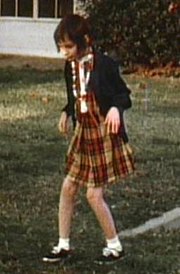In Dr.Wedes Psychology course we have learned about the brains plasticity and the concepts of empiricism and nativism. Nativism is the idea that our thoughts and ideas are inborn. Empiricism is the idea that knowledge is gained through experience. We now know that the brain is mostly sculpted by our genes but also relies on our experiences and changes due to plasticity. The plasticity of the brain describes the brains ability to modify itself after some type of injury or illness. We learned that the plasticity of the brain is much more resilient in children.
While talking about the concept of plasticity concept I couldn’t help but think about Genie Wiley. In my psychology class in high school we learned about a young girl named Genie who is known as the ‘feral child’ because she lived in almost complete isolation for her entire childhood.


Above are pictures of Genie after she was rescued. From the time she was born she spent her life locked in a small bedroom and was abused. She was not taught any form of language and was beaten any time she made any type of noise. She had trouble walking and controlling her voluntary movements. This is certainly a unique case and would be an unethical experiment but, it is an intriguing case to gain information from. Once Genie was saved by child services, she was assigned a rehabilitation team to help her. Unfortunately, the psychologist on the team described Genie as the most damaged child she had ever seen. The psychologist compared Genie’s emotional and cognitive abilities to a one year old. Although Genie was able to learn a few more words over time a linguist concluded that Genie would never be able to fully be able to comprehend or speak language (Cherry). She could not put sentences together and did not understand the idea of grammar. This helped to prove to psychologists that learning language needs to be done during a critical time in a child’s life. “The ‘critical period’ theory states that there is a very specific period when a child needs to learn their first language, or they will never have full command over the language” (Villarreal). Genie clearly missed this period in her life while she was isolated from all human interaction.

https://developingchild.harvard.edu/science/key-concepts/brain-architecture/
This simple chart from Harvard University exemplifies how hard it can be for the brain to adapt after the age of ten and the amount of effort it requires from that point on. Genies case is unique because she suffered abuse and social isolation making her case more severe. The plasticity of Genie’s brain was not able to change or adapt even though she was experiencing new things. This is a real-life case of how important early learning and plasticity of the brain is. Since Genie’s case was so extreme her brain was unable to adapt but in many situations of damage the human brain is able to recover and adapt.
Works Cited
Cherry, Kendra. “The Story of ‘Genie,” a Child Deprived of Nearly All Human Contact.” Verywell Mind, Verywell Mind, 30 June 2019, www.verywellmind.com/genie-the-story-of-the-wild-child-2795241.
Villarreal, Daniella. “Genie Wiley: The Feral Child.” StMU History Media, 29 Mar. 2019, stmuhistorymedia.org/genie-wiley-the-feral-child/.
“Brain Architecture.” Center on the Developing Child at Harvard University, developingchild.harvard.edu/science/key-concepts/brain-architecture/.
The Feral child is a perfect example of the brains plasticity. I also learned about the feral child in my high school psychology class. It goes to show how vital development is at a young age because if some issues go untouched by parents, it could hinder a kids development for the rest of their life. If we don’t develop the mechanism early to have the ability to learn, it will be harder to develop new skills at an older age that may be needed. There was one case study we looked at where a boy had to get brain surgery. A large portion of the right side of his brain would have to be removed. It was believed he would struggle with face recognition, sight, and the ability to recognize words. Because of the brains plasticity, those functions were taken over by the other side of his brain. The only thing affected was that he couldn’t see out the left half of his visual field. It’s incredible how if the brain is developed right, it can actively learn new things and adapt to damaged areas.